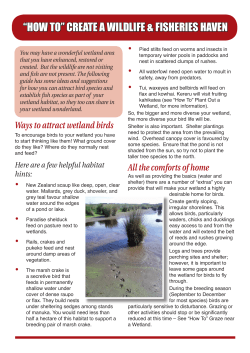
4 Taking Action to Restore and Protect
37 4 Taking Action to Restore and Protect Nottawasaga Watershed Improvement Program Fred Dobbs, Manager of Stewardship Services Sarah Campbell, Aquatic Biologist Robert Waind, N‐WIP Steering Committee Chair Scott Martin, N‐WIP Steering Committee Member Fred Dobbs (Manager of Stewardship Services for the Nottawasaga Watershed Improvement Program (N‐WIPP)) and Sara Campbell (Aquatic Biologist) explained that the Lake Huron Georgian Bay Framework for Community Action strives to empower people to take action to protect and enhance the health of the Lake Huron‐ Georgian Bay Watershed. This community‐based approach empowers individuals, communities and organizations to operate independently and through their own actions to protect and enhance Lake Huron Georgian Bay. Under this Framework, the Lower Nottawasaga River Basin was selected as one of the 3 ‘pilot project’ areas by the Lake Huron Steering Committee. The surface water quality information (D) presented in the NVCA’s 2007 Watershed Report Card was a key factor in the committee’s selection of the Lower Nottawasaga basin. To initiate the pilot project, the NVCA submitted a proposal for a water quality improvement program. The purpose of the N‐WIP is to improve the health of Georgian Bay (Lake Huron) and the Nottawasaga River by partnering with local communities to complete water quality improvement projects on tributary streams. Since 2007 the N‐WIP has received project funding from: Environment Canada (e.g. Great Lakes Issues Management and Reporting Section and Eco Action Program (2011‐14)) The Province of Ontario (e.g. Ministry of the Environment and Climate Change ‐ Southwestern Region, Ministry of Natural Resources and Forestry) Corporate sponsorship (e.g. Somerville Nurseries, R.J Burnside, Canadian Mist and Ainley Group) Most recently the NVCA and N‐WIP were successful in accessing additional funding support for 2014‐2016 through the Federal Lake Simcoe/South‐eastern Georgian Bay Clean Up Fund NVCA Municipal Levy. N‐WIP has engaged the community through bank stabilization with an aquatic habitat focus, flood plain creation and livestock exclusion fencing. The top ten tips that N‐WIP would offer after undertaking these community engagement projects include: The types of projects that have been completed include: Volunteer streamside tree planting Strategic professional streamside tree planting Negotiation of buffer strips along waterways Stream bank stabilization and stream habitat improvement Natural channel restoration Experiential learning opportunities Working in partnership with farmers to fence livestock out of streams Take Action The N‐WIP Steering Committee membership is comprised of strategic partner representation ranging from educational institutions, agricultural organizations, angling groups, commercial enterprises and municipalities. 38 TIP #1 ‐ Emphasize Hands‐on Activities Experiential learning is a key driver in engaging the community. Each year in collaboration with the Wasaga Beach Healthy Communities Network and other community partners, a free interpretive canoe trip is held. Participants actually get to see the natural aspects of the river. They learn the value of a riffle and take water samples. This program has been so successful additional trips have been planned during the year. TIP #2 ‐ Know Your Audience Understanding the social demographic characteristics of the audience is critical to ensuring successful engagement. Farmers are more likely to respond to individual contact while others may enjoy a public workshop. TIP #3 ‐ Engage School Programs Environmentally focused programs with secondary schools are very popular. Students love to get into the water and to get their hands dirty. Target a teacher who is a specialist at the school and wants to be engaged. Once they have been trained, they can deliver the program themselves the next year. Sometimes teachers are so interested they begin to participate beyond the class setting. N‐WIP now has a teacher that volunteers to write grant applications. Work with recreationally focused groups who already value the natural environment. N‐WIP joined a fly fish workshop and was able to provide a presentation to build awareness of their program. Canoe and Kayak clubs are also good partners and contributed to the interpretative canoe trips identified in Tip #1. TIP #5 ‐ Focus on Multi‐Year Projects/Partnerships Every year N‐WIP engages community members and students to plant trees on Black Ash Creek. A contractor could do it faster, but each year those who participate can see the results of their hard work. Take Action TIP #4 ‐ Incorporate Water Based Recreation Themes 39 TIP #6 ‐ Be Creative With Partnership Development Seek out creative partnerships within the community. N‐WIP was able to develop a relationship with a local nursery retailer who supplied new innovative anchors for plantings. Tip #7 ‐ Don't Underestimate the Lure Of Fish Working with fish and anglers can result in tremendous engagement and action on the ground. An interest in fish leads to an interest in the watercourse and in taking action to improve it. An electro‐fishing demonstration shows the fish that are in the river and kids (and adults) love it. TIP #8 ‐ Market Your Brand TIP #9 ‐ Celebrate Accomplishments Recognize the work of volunteers and be sure to take your funders and municipal representatives out to see the work the community has accomplished. TIP#10 ‐ Support Steering Committee Be sure to support the group of volunteers and partner representatives that are the backbone of your program. Make sure that they also receive recognition for their contribution. Take Action Identify projects consistently for recognition. Be humble and make sure partners are also recognized because everyone in the group benefits and it demonstrates collaboration 40 Protecting the Silver Creek Wetland Complex through the Transfer of Land Ownership Norm Wingrove, George Powell ‐ The Blue Mountain Watershed Trust ‐ Day 1 The Blue Mountain Watershed Trust Foundation (BMWTF) was founded in 1994 and was Ontario’ first watershed trust. The impetus for the formation of BMWTF came from the Blue Mountain Watershed Conference held in May of 1993 in order to develop awareness and promote partnerships that are required in order to successfully implement watershed planning in the Blue Mountain watersheds. The Blue Mountain Watershed Trust Foundation is an independent grass‐roots organization and a Registered Charity. With more than 148 members, who have a deep appreciation of and a passion for nature and are concerned about the future of this area, the BMWTF is a volunteer organization that is supported by donations and fundraising. The Blue Mountain watershed boasts a unique and diverse natural environment. It supports a wide array of terrestrial and aquatic habitat. The region is much cherished for its natural beauty and this has attracted many visitors and permanent residents to the area. Nowhere does the Niagara Escarpment dominate the landscape as it does in the Blue Mountain watershed. The Niagara Escarpment was named a Biosphere Reserve in 1990 by the United Nation’s Bureau of Educational, Scientific and Cultural Organization (UNESCO). This designation constitutes world recognition based on the Escarpment’s unique natural features, ecological importance, and as land regulated and protected under the Niagara Escarpment Plan of 1985. The Silver Creek Wetland complex is a provincially significant wetland and encompasses about 440 acres in total area. Most of it is located in the Town of Collingwood, within the jurisdiction of the Nottawasaga Valley Conservation Authority, and a smaller portion is in the Town of The Blue Mountains, within the jurisdiction of the Grey Sauble Conservation Authority. This area is under significant development pressure in both municipalities. A unique five party agreement was struck between the Town of Collingwood, the Town of Blue Mountains, Nottawasaga Valley Conservation Authority (NVCA), Grey Sauble Conservation Authority and the Niagara Escarpment Commission to address the protection of the Take Action Because of this unique natural environment and geographic location, the watershed is under great pressure to support increased residential development, expansion of recreational areas, aggregate extraction and other urban and rural activities that could have serious environmental impacts (e.g., degraded water quality, loss of wetlands). Because of its ecological value, the Watershed Trust is committed to ensuring the continued environmental health and integrity of the watershed 41 Silver Creek Wetland complex. The general concept of the agreement was that when development applications are being reviewed in the Silver Creek Wetland complex, that the parties would seek opportunities to transfer the ownership of wetlands out of private ownership. It was agreed that the Town will monitor the application process and the lands, and NVCA will look after its ecosystem values and do any enforcement. Some of the lands are within the Grey Sauble Conservation Authority jurisdiction, however, they have agreed to allow the Nottawasaga Valley Conservation Authority to monitor and manage the process. The added value of this agreement was that a Management Plan would be created for the transferred lands. Since the agreement has been put in place, it has been tested a number of times as development applications were processed. In the Town of Collingwood, four developments were subject to this process and 2 resulted in conditions that would protect about 120 acres of wetlands, collectively, by deeding them to the Town. Two other developments in Collingwood have stalled either due to suspension of OMB mediation or the developers reluctance to release title of the lands. In the Town of The Blue Mountains, 2 developments are expected to deed a total of 35 acres to the Town. Looking at the entire Silver Creek Wetland complex, there is great potential to transfer ownership of other wetland areas to the local municipalities. The hatched areas is an estimate of the lands that could potentially be transferred out of private ownership through development applications ‐ or donations. There is a total of about 280 acres plus an unknown amount in Huntingwood Trails. This approach seeks maximum protection for the Silver Creek Wetland complex by gradually transferring the ownership of wetland areas out of private hands into public ownership at a minimal cost. With five agencies working together to monitor development applications, manage the process, and develop a management plan, this approach protects and enhances the silver creek wetland for its many benefits for generations to come. Take Action
© Copyright 2025




![[Test] NVCA conservationUPDATE](http://cdn1.abcdocz.com/store/data/000416153_1-f855acfa24c25b6e27921ab428bb9274-250x500.png)







